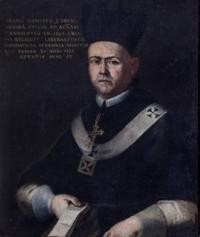Si è distinto per singolare intelligenza, cultura e capacità di governo. Nel 1703 ha celebrato il Sinodo diocesano. Ha sostenuto la lotta per le immunità ecclesiastiche e l’indipendenza del vescovo dal potere temporale. Costretto ad interdire la diocesi è stato esiliato a Malta.
Nel 1711 ha fondato il Collegio dei SS. Agostino e Tommaso per il perfezionamento della formazione dei chierici che completavano i loro studi in Seminario, consentendo un specializzazione in Morale e Diritto. Il modello scelto era quello dell'antica Università di Salamanca. Dotò il Collegio di una rendita il Feudo Durrueli, che doveva servire per la carità e mantenere gli studi dei collegiali.
Il 2 gennaio del 1711 ha inizio la costruzione del Collegio e la struttura viene unificata quella del Seminario. La prima parte della costruzione viene terminata nel luglio del 1713 . Destinò a uso comune del Seminario e del Collegio, la cappella, tutto il pianterreno e la biblioteca che arricchì di nuovi libri, dove rimase fono al 1958. Per le lezioni ha commissionata un’apposita aula, ornata di stalli e di una cattedra monumentale, scolpita in legno dall’artista agrigentino Onofrio Vicari, con la collaborazione dello scultore trapanese, Rocco Jacopelli. I lavori sono stati completati dai suoi successori, i vescovi La Pegna e Gioeni, tra il 1723 e il 1731. Durante il suo episcopato vengono completate le decorazioni del cappellone con stucchi ed emblemi. Sette quadri, dipinti a fresco dal pittore palermitano Vincenzo Bongiovanni, ricostruiscono la storia dei vescovi agrigentini. Iniziando da destra, nelle due pareti laterali dominano: San Giacomo, che cavalcando un cavallo bianco, vince la sua battaglia contro i mori; di fronte San Gerlando, sullo sfondo di un tempio, predica al suo popolo agrigentino che ha ricristianizzato; segue il Battesimo di San Gregorio agrigentino, tenuto da San Potamione, e sullo sfondo i suoi genitori Caritone e Teodota; il martirio di San Libertino; San Gregorio agrigentino mentre celebra i sacri misteri; San Gregorio I che accoglie le reliquie di sant’Agrippina e le sue sorelle Bassa, Paola e Agatonica.
Muore a Roma ed è sepolto nella chiesa di santa Maria alla Minerva dei Padri Domenicani.

